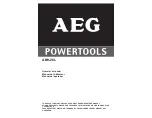
12
HAMMERDRILL OPERATION (FIG. 3)
1. Turn the mode selector (D) to the rotary hammer symbol (J).
2. When drilling, use just enough force on the hammer to keep it from bouncing
excessively or “rising” off the bit. Too much force will cause slower drilling
speeds, overheating, and a lower drilling rate.
3. Drill straight, keeping the bit at a right angle to the work. Do not exert side
pressure on the bit when drilling as this will cause clogging of the bit flutes and a
slower drilling speed.
4. When drilling deep holes, if the hammer speed starts to drop off, pull the bit
partially out of the hole with the tool still running to help clear debris from the
hole.
5. For masonry, use carbide-tipped bits or masonry bits. A smooth even flow of
dust indicates the proper drilling rate.
Chipping and Chiselling (Fig. 3)
WARNING: To reduce the risk of serious personal injury, turn the tool off and
disconnect the battery pack before making any adjustments or removing/installing
attachments or accessories.
An accidental start-up can cause injury.
1. Set the mode selector switch (D) to the chipping symbol (K).
2. Insert the appropriate chisel and rotate it by hand to lock it into one of 51
positions.
3. Adjust the side handle as required.
4. Switch on the tool and start working.
5. Always switch off the tool when work is finished and before unplugging.
MAINTENANCE
WARNING: To reduce the risk of serious personal injury, turn the tool off and
disconnect the battery pack before making any adjustments or removing/installing
attachments or accessories.
An accidental start-up can cause injury.
Lubrication
Your power tool requires no additional lubrication.
Cleaning
WARNING:
Blow dirt and dust out of all air vents with clean, dry air at least once
a week. To minimize the risk of eye injury, always wear AS/NZS1337 approved eye
protection when performing this.
WARNING:
Never use solvents or other harsh chemicals for cleaning the
non-metallic parts of the tool. These chemicals may weaken the plastic materials
used in these parts. Use a cloth dampened only with water and mild soap. Never let
any liquid get inside the tool; never immerse any part of the tool into a liquid.
CHARGER CLEANING INSTRUCTIONS
WARNING:
Shock hazard. Disconnect the charger from the AC outlet before
cleaning. Dirt and grease may be removed from the exterior of the charger using a
cloth or soft non-metallic brush. Do not use water or any cleaning solutions.
Repairs
This charger and battery pack are not serviceable. Servicing at an authorized service
centre is required to avoid damage to static sensitive internal components.
To assure product SAFETY and RELIABILITY, repairs, maintenance and adjustment
(including brush inspection and replacement) should be performed by certified
service centers or other qualified service organizations, always using identical
replacement parts.
Accessories
WARNING:
Since accessories, other than those offered by D
E
WALT, have not been
tested with this product, use of such accessories with this tool could be hazardous.
To reduce the risk of injury, only D
E
WALT recommended accessories should be used
with this product.
Recommended accessories for use with your tool are available at extra cost from
your local service center. If you need any assistance in locating any accessory, please
contact Stanley Black & Decker, 82 Taryn Drive, Epping, VIC 3076 Australia or call
1800 338 002 or (NZ) 0800 339 258.
Maximum Recommended Capacities
Spindle speed
0–1,200 min
-1
Hammering speed
0–4,500 min
-1
Bits, masonry drilling
22.2 mm (7/8")
Summary of Contents for DCH253-XE
Page 1: ...DCH253 XE DCH254 XE HEAVY DUTY 18V CORDLESS ROTARY HAMMER INSTRUCTION MANUAL ...
Page 2: ......
Page 15: ......


































